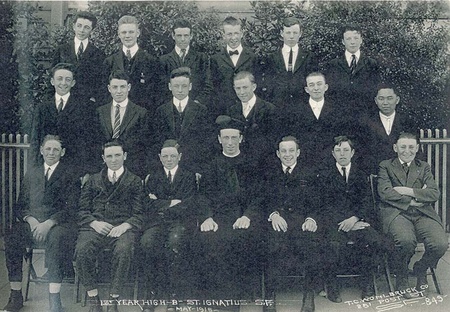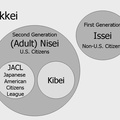>> Read part 3
Kurihara did very well in courses in Roman and Greek history. As David Tyack notes, history textbooks “reveal what adults thought children should learn about the past and are probably the best index of what young Americans did learn in class.” Kurihara’s first-year textbook, Evelyn Shuckburg’s A History of Rome for Beginners, is of particular interest. One of its five parts focuses on the constitutional history of Rome and the continual “struggles of the plebeians for equality” and “civil rights.”1 These ideas, whatever the intentions of the English author Schuckburg, served the school’s effort to promote concepts in keeping with Americanism. In the other parts of the book, interwoven with the narrative of battles and wars was the theme of civil strife and revolt by those less powerful. One wonders if, years later—faced with his confinement at Manzanar—Kurihara saw parallels in the situation of the Nikkei with the situation of the plebeians and slaves, who sought ways to oppose the overwhelming power of the state and the patricians who ran it (figure 1).

Figure 1. Kurihara and first-year high school classmates at St. Ignatius School, San Francisco, May 1915. Courtesy University of San Francisco Archives.
In addition to history, Kurihara studied elocution, which was not new to him; he had been introduced to it earlier at St. Francis School. At St. Ignatius, rhetoric and elocution were important subjects, as they were in many schools across the country. As a result, numerous books were available for students’ recitation.2
St. Ignatius awarded a gold medal for the winner of its annual elocution contest and another for the “best debater” at its annual debate competition. Participation in these events was voluntary and Kurihara took up the challenge: During his second year at the school, he was one of only two students in his class who participated in the elocution contest. By this time his grade in elocution had improved substantially, from a percentage of 75 in his first year, to 93 in his second year. In this environment Kurihara gained confidence as a public speaker and experienced the pleasure and power of oratory. Years later at Manzanar he would use what he learned to his advantage in his many speeches that sought to convince his fellow inmates of the injustice of their incarceration.3
Ideas of justice and civil rights, expressed in Kurihara’s history classes, were reinforced in his elocution exercises. For his delivery prepared for the contest, Kurihara selected “Rienzi’s Address to the Romans,” part of a larger production written by Mary Russell Mitford. Kurihara would recite the poem over and over with expression, until he knew the poem by heart.4
The Roman Rienzi had led a successful revolt against the nobles. He then became a tribune, whose role was to protect the people against oppression, and introduced many governmental reforms. In this address, Rienzi calls on the people to rebel in the name of freedom. The parallel with Kurihara’s self-appointed role at Manzanar—where he spoke before his fellow inmates numerous times, urging them to protest their incarceration—is striking. While one should not read too much significance into one selection, it should be noted that Kurihara memorized this speech for the elocution contest and the intent of Rienzi’s oration, if not the words, would have remained with Kurihara long after he left the school.
Kurihara’s selection, like the selections of the other students participating in the school’s elocution contest, was not used solely in Catholic schools like St. Ignatius. These selections could be found in the popular McGuffey Readers and other schoolbooks that saw widespread use in public and private schools. In fact, according to Timothy Walch, who examined both public and parochial schoolbooks, few differences between them existed “in form and content.”5
These readers included selections that reflected values that middle-class Americans wanted to instill in the youth. In this context, St. Ignatius did its part. Selections of other students participating in the elocution contest provide a glimpse of the themes that students were exposed to: in Elijah Kellogg’s “Spartacus to the Gladiators,” Spartacus calls on his fellow gladiators to battle their oppressors; Patrick Henry’s “Liberty or Death” oration speaks of noble struggles and principled action; Eleanor Donnelly’s “Gualberto’s Victory” brings together ideas of Christian forgiveness and heroism; and Robert Walker’s “The Level Crossing” and James Buckham’s “The Race at Devil’s Elbow” present ideas of redemption and heroism.6
Kurihara and his schoolmates were thus exposed to literature aimed at Americanizing them, many of whom—like Kurihara—were immigrants or children of immigrants. Such was the paradoxical nature and inherent tension of Kurihara’s Catholic education: Within a hierarchical system, his religion classes and the school’s expectations emphasized respect for authority and obedience to Catholic doctrine at the same time that his history and elocution lessons exposed him to notions of freedom, heroic action, and resistance. To be sure, the paradox of schooling—the tension between ideas of democracy and the reality of school life—was not unique to Kurihara’s experience, nor to that of his schoolmates and other students enrolled in Catholic schools, nor can it be said that Kurihara and his schoolmates were necessarily bothered by it or even aware of it at the time. More important was what St. Ignatius High School gave Kurihara: a nurturing of notions of justice for ordinary people, and an appreciation of the power of oration to defend their rights. They helped shape the way in which he responded, years later, to the incarceration of Japanese Americans during World War II.7
Notes:
1. Kurihara received an average score of 81 percent in his first-year history course and a 91 percent in his second year, which were very good scores in this Jesuit preparatory school. David Tyack, “Monuments between Covers: The Politics of Textbooks,” American Behavioral Scientist 42, no. 3 (1999): 922; Evelyn S. Shuckburgh, A History of Rome for Beginners: From the Foundation of the City to the Death of Augustus (London: Macmillan and Co., 1913 [1897]), 35, 38. Kurihara’s second-year textbook, William S. Robinson’s A Short History of Greece (New York: Macmillan and Co., 1895), 57, 292, mentions Athens’ development into a “champion of democracy” and also refers to Demosthenes, but most of the book discusses battles and wars.
2. R. C. H. Morison, Chambers’s New Reciter (London: W. & R. Chambers, 1901), v, xiii, discusses the growing emphasis of elocution in the schools in the early 1900s and the many books published for recitation, including his Chambers’s New Reciter. Another example is S. S. Curry’s Little Classics, with Initiative Steps in Vocal Training for Oral English (Boston: Expression Company, 1912).
3. For information on the gold medals, see Catalog of St. Ignatius University, 1916-1917, 119, RG4 Catalogs, University of San Francisco Archives. For the elocution program, see Catalog of St. Ignatius University, 1917-1918, 102-103, RG 4 Catalogs, University of San Francisco Archives.
4. Mary Russell Mitford (1787-1855) of Hampshire, England, was a poet, playwright, and novelist who saw a number of her plays performed during her lifetime. “Rienzi’s Address” is in McGuffey’s Sixth Eclectic Reader (New York: John Wiley & Sons, 1907), 221-23; and Standard Classics, A Fifth Reader (Boston: Educational Publishing Co., 1910), 173-75. After introducing many reforms, Rienzi unfortunately abused his power and was eventually assassinated.
5. Walch, Parish School, 73.
6. A list of the elocution contest titles are in Catalog of St. Ignatius University, 1917-1918, 102.
7. According to his older sister, before he left for San Francisco, Kurihara had already demonstrated a tendency to take action in the name of justice. Hanako Marubayashi (Kurihara’s niece), interviewed by author, 21 September 2005, Honolulu.
* This essay was the History of Education Society Presidential Address delivered at the annual meeting in Philadelphia, October 2009 and published in History of Education Quarterly, Vol. 50, No.1 (January 2010).
** The definitive version is available at www.blackwell-synergy.com.
© 2010 The History of Education Society





